RAM price surges by 172 percent increase

The world of technology is constantly evolving, and one of the most critical components in this ecosystem is Random Access Memory (RAM). Recently, the market has seen a staggering increase in RAM prices, particularly affecting those looking to upgrade or build new systems. Understanding the factors behind this surge is essential for consumers and industry stakeholders alike. Let's dive into the reasons behind the sharp rise in RAM prices and what it means for the future of computing.
Understanding the dramatic rise in RAM prices
Recent reports indicate a shocking 172% increase in RAM prices on the spot market since July. This surge is not just a minor blip; it reflects a significant shift in the dynamics of supply and demand that is affecting consumers worldwide. With 32 GB DDR5 packs now exceeding €200, many are left questioning the sustainability of these prices.
Several factors contribute to this situation, with one of the most prominent being the explosive demand from the artificial intelligence (AI) sector. The insatiable need for memory to support AI operations has led to a drastic depletion of available stock, significantly impacting prices.
The role of AI in driving RAM demand
AI technologies require massive amounts of data processing power, which in turn requires substantial RAM resources. As companies race to develop and deploy AI solutions, they are consuming memory chips at an unprecedented rate. Notably, major manufacturers like Samsung and SK Hynix are struggling to keep up with this demand.
- Order fulfillment rates have plummeted to around 70%.
- Safety stock reserves are being depleted rapidly.
- Manufacturers are prioritizing server RAM production due to higher profitability.
This shift in production focus means that consumers may face even higher prices as manufacturers redirect resources to meet the needs of more lucrative server markets rather than the general consumer market. For example, the cost of a 16 GB chip has nearly doubled, jumping from $7 to $13. Such increases inevitably trickle down to consumers, who are now feeling the pinch at retail outlets.
Current market landscape for RAM
The impact of these price hikes is evident across various retailers. For instance, French retailer Top Achat has reported that there are no 32 GB DDR5 kits available for less than €200. This trend is mirrored in other segments of the market, where even entry-level kits are nearing €215 for 6400 MT/s speeds. Popular brands like Corsair have also seen their prices surge, with discounts no longer reflecting the previously lower prices seen just months ago.
On platforms like Amazon, where consumers once found competitive pricing, the landscape has changed drastically. What was once a €100 kit in August or September is now priced at around €153, even with a discount. This significant shift underscores the broader trend affecting many consumers looking to upgrade their systems.
Forecasting future RAM prices
Industry leaders are voicing concerns about the sustainability of current RAM prices. According to ADATA’s CEO, it is likely that these inflated prices will persist for the foreseeable future. Meanwhile, Phison Electronics' CEO posits that the current trends could last as long as a decade.
This long-term outlook is troubling for consumers and businesses alike. Price stability is crucial for planning budgets, especially for those in fields where technology upgrades are necessary for operations. The following factors could influence future price trends:
- Continued growth in AI and machine learning sectors.
- Potential new entrants in the RAM production market.
- Technological advancements leading to more efficient manufacturing processes.
Strategies for consumers facing rising RAM prices
As prices continue to climb, consumers should consider several strategies to navigate the volatile RAM market:
- Monitor prices regularly: Stay updated on market trends and pricing changes to make informed purchases.
- Consider alternative brands: Look for lesser-known brands that might offer competitive pricing without sacrificing quality.
- Optimize existing hardware: Sometimes, upgrading other components can yield better performance without the need for additional RAM.
- Buy in bulk: If feasible, consider purchasing larger quantities at once to take advantage of bulk pricing.
- Utilize second-hand markets: Explore options for used or refurbished RAM, which can often be found at lower prices.
The long-term implications for technology and consumers
The ramifications of rising RAM prices extend beyond just immediate costs; they could reshape the technology landscape. As companies adapt to these challenges, we may see:
- A shift in consumer preferences towards more cost-effective technologies.
- Increased investment in alternatives to traditional RAM.
- Greater emphasis on recycling and sustainability in technology production.
In this evolving landscape, technology enthusiasts and casual users alike must stay informed and adaptable. The market for RAM, once seen as stable, is experiencing unprecedented changes driven largely by the burgeoning AI sector.
To gain further insights on this topic, check out this video:
As we look to the future, it remains to be seen how companies will adapt to these challenges and what innovative solutions may arise to mitigate the impacts of these rising costs. For consumers, being proactive and informed will be key in navigating this new landscape.




Leave a Reply